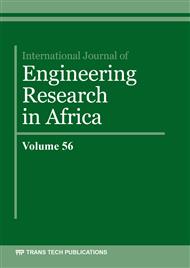[1]
E.E. Okoro, A. Dosunmu and S. Iyuke, Data on Cost analysis of drilling mud displacement during drilling operation, Data in Brief, 19 (2018) 535-541. https://doi.org/10.1016/ j.dib.2018.05.075.
DOI: 10.1016/j.dib.2018.05.075
Google Scholar
[2]
E.E. Okoro, A. Dosunmu and S. Iyuke, Silicon Ethoxide as reversible surfactant in reversible drilling mud and the mud's effect on permeability, Journal of King Saud University-Engineering Science, 32 (2019) 402-406. https://doi.org/10.1016/j.jksues.2019.04.003.
DOI: 10.1016/j.jksues.2019.04.003
Google Scholar
[3]
K.C. Igwilo, E.E. Okoro, O. Agwu, C. Onedibe, S.I. Ibeneme, N.O. Okoli, Experimental Analysis of Persea americana as Filtration Loss Control Additive for Non-Aqueous Drilling Fluid, International Journal of Engineering Research in Africa, Vol. 44 (2019) pp.8-21.
DOI: 10.4028/www.scientific.net/jera.44.8
Google Scholar
[4]
K. Song, Q. Wu, M.C. Li, A.K. Wojtanowicz, L. Dong, X. Zhang, S. Ren and T. Lei, Performance of low solid bentonite drilling fluids modified by cellulose nanoparticles, Journal of Natural Gas Science and Engineering 34 (2016) 1403-1411.
DOI: 10.1016/j.jngse.2016.08.036
Google Scholar
[5]
B.A. Adelabu, S.O. Kareem, F. Oluwafemi and I.A. Adeogun, Bioconversion of corn straw to ethanol by cellulolytic yeasts immobilized in Mucuna urens matrix. Journal of King Saud University-Science, 31(2019) 136-141.
DOI: 10.1016/j.jksus.2017.07.005
Google Scholar
[6]
R. Rafati, S.R. Smith, A.S. Haddad, R. Novara and H. Hamidi, Effect of nanoparticles on the modifications of drilling fluids properties: A review of recent advances, Journal of Petroleum Science and Engineering 161 (2018) 61–76.
DOI: 10.1016/j.petrol.2017.11.067
Google Scholar
[7]
D.S. Udawattha, M. Narayana and U.P.L. Wijayarathne, Predicting the effective viscosity of nanofluids based on the rheology of suspensions of solid particles, Journal of King Saud University – Science 31 (2019) 412–426.
DOI: 10.1016/j.jksus.2017.09.016
Google Scholar
[8]
D.S. Raghuvanshi, N. Verma, S.V. Singh, S. Khare, A. Pal and A.S. Negi, Synthesis of thymol-based pyrazolines: An effort to perceive novel potent-antimalarials, Biorganic Chemistry, 88 (2019) 102933.
DOI: 10.1016/j.bioorg.2019.102933
Google Scholar
[9]
N.V. Boyou, I. Ismail, W.R. Sulaiman, A.S. Haddad, N. Husein, H.T. Hui and K. Nadaraja, Experimental investigation of hole cleaning in directional drilling by using nano-enhanced water-based drilling fluids, Journal of Petroleum Science and Engineering 176 (2019) 220-231.
DOI: 10.1016/j.petrol.2019.01.063
Google Scholar
[10]
H. Elochukwu, L.K. Sia, R. Gholami and M.A. Hamid, Data on experimental investigation of Methyl Ester Sulphonate and nanopolystyrene for rheology improvement and filtration loss control of water-based drilling fluid, Data in Brief 21 (2018) 972–979.
DOI: 10.1016/j.dib.2018.10.055
Google Scholar
[11]
M. Alsaba, R. Nygaard, G. Hareland and O.Contreras, Review of Lost Circulation Materials and Treatments with an Updated Classification, Paper AADE-14-FTCE-25 presented at the 2014 AADE Fluids Technical Conference and Exhibition, Houston, (2014) Texas.
Google Scholar
[12]
O.E. Agwu and J.U. Akpabio, Using agro-waste materials as possible filter loss control agents in drilling muds: A review, Journal of Petroleum Science and Engineering 163 (2018) 185-198.
DOI: 10.1016/j.petrol.2018.01.009
Google Scholar
[13]
A.M. Raheem and C. Vipulanandan, Testing and modeling of filter cake formation using new seepage-consolidation concept, Engineering Science and Technology, an International Journal, (2019) https://doi.org/10.1016/j.jestch.2018.12.009.
DOI: 10.1016/j.jestch.2018.12.009
Google Scholar
[14]
E.E. Okoro, K.C. Igwilo, A.O. Mamudu, E.B. Ekeinde and A. Dosunmu, Data on shale-water based drilling fluid interaction for drilling operation, Data in Brief, 19 (2018) 1620-1626.
DOI: 10.1016/j.dib.2018.06.014
Google Scholar
[15]
E.B. Ekeinde, E.E. Okoro, A. Dosunmu and S. Iyuke, Optimizing aqueous drilling mud system viscosity with green additives. Journal of Petroleum Exploration and Production Technology, (2018). https://doi.org/10.1007/s13202-018-0481-0.
DOI: 10.1007/s13202-018-0481-0
Google Scholar
[16]
C.P. Ezeakacha, S. Salehi and R. Kiran, Lost circulation and filter cake evolution: Impact of dynamic wellbore conditions and wellbore strengthening implications, Journal of Petroleum Science and Engineering, 171 (2018) 1326–1337.
DOI: 10.1016/j.petrol.2018.08.063
Google Scholar
[17]
Y. Feng and K.E. Gray, Wellbore strengthening models. In: Lost Circulation and Wellbore Strengthening, SpringerBriefs in Petroleum Geoscience & Engineering, (2018) Springer, Cham.
DOI: 10.1007/978-3-319-89435-5_4
Google Scholar
[18]
A. Rabbani and S. Salehi, Dynamic modeling of the formation damage and mud cake deposition using filtration theories coupled with SEM image processing, Journal of Natural Gas Science and Engineering, 42 (2017) 157-168.
DOI: 10.1016/j.jngse.2017.02.047
Google Scholar
[19]
M.I. Abdou, A.M. Al-Sabagh, H.E. Ahmed and A.M. Fadl, Impact of barite and ilmenite mixture on enhancing the drilling mud weight, Egyptian Journal of Petroleum 27 (2018) 955–967.
DOI: 10.1016/j.ejpe.2018.02.004
Google Scholar
[20]
C.Y. Ho, S. Yusup and C.V. Soon, Rheological Behaviour of Graphene Nano-sheets in Hydrogenated Oil-based Drilling Fluid, Procedia Engineering, 148 (2016) 49–56. https://doi.org/10.1016/j.proeng.2016.06.490.
DOI: 10.1016/j.proeng.2016.06.490
Google Scholar
[21]
Y. A. Cengel, and J.M. Cimbala, FLUID MECHANICS Fundamentals and Applications, Vol. 2. McGraw-Hill, (2010).
Google Scholar
[22]
T.G. Mezger, The Rheology Handbook. European Coatings Tech Files, 3rd revised edition, (2011).
Google Scholar
[23]
L.E. Vallejo and R. Mawby, Porosity influence on the shear strength of granular material–clay mixtures. Eng Geol, 58 (2) (2000) 125-136.
DOI: 10.1016/s0013-7952(00)00051-x
Google Scholar
[24]
S. Kafashi, Mohamadreza Rasaei, Gholamreza Karimi, Egyptian Journal of Petroleum (2017) 26, 371–374.
Google Scholar
[25]
A. Genc, O. Zeydan and S. Sarac, Cost analysis of plastic solid waste recycling in an urban district in Turkey. Waste Management and Research, Vol. 37, Issue 9, (2019) 1-8. https://doi.org/10.1177/0734242X19858665.
DOI: 10.1177/0734242x19858665
Google Scholar
[26]
O. E. Agwu, J. U. Akpabio and G. W. Archibong, Rice husk and saw dust as filter loss control agents for water-based muds. Heliyon, Vol. 5(7), (2019) e02059, https://doi.org/10.1016/j.heliyon.2019.e02059.
DOI: 10.1016/j.heliyon.2019.e02059
Google Scholar
[27]
R. Ahmed and S. Miska, Experimental study and modeling of yield power-law fluid flow in annuli with drillpipe rotation. SPE 112604. IADC/SPE. In: SPE/AIADC Drilling Conference held in Orlando, Florida, USA 4-6 March, (2008).
DOI: 10.2118/112604-ms
Google Scholar
[28]
S. Zhuang, K. Zhu, J. Wang, Fibrous chitosan/cellulose composite as an efficient adsorbent for Co(II) removal. Journal of Cleaner Production, 285, (2020) 124911. https://doi.org/10.1016/ j.jclepro.2020.124911.
DOI: 10.1016/j.jclepro.2020.124911
Google Scholar
[29]
H. T. Sahin and M. B. Arslan, A study on physical and chemical properties of cellulose paper immersed in various solvent mixture. International Journal of Molecular Science, Vol. 9, (2008) 78-88.
DOI: 10.3390/ijms9010078
Google Scholar


